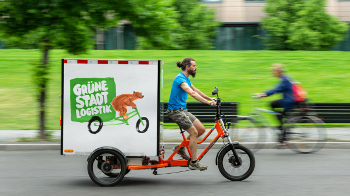Most users of our system have their own logistics, which has proven particularly useful in these pandemic times: not only is the quality under their own control, but the lack of capacity is also easier to manage. In addition, in-house optimisations typically result in very efficient (and low CO2) delivery.
Bikes, drones
But service providers can of course help, especially when it comes to peak times, or specialists, e.g. bike messengers in city centres, (limited) electric vehicles or drone deliveries. Sometimes this becomes a permanent collaboration, beyond helping during rush hours.
Ok, we actually can’t report a cooperation with a drone delivery service yet, but we already have some experience with bicycle delivery services. It is possible to transfer the relevant data (addresses, weights, number of boxes, sizes) to the IT of the respective partners, usually once the packing process has been completed. Depending on how these partners have organised their drivers, the order of the boxes at the transfer point is also important, and this can deviate from the internal optimisation.
It could even go so far that the partners receive a preview of the upcoming deliveries before the actual order deadline or the end of packing – and then report their desired packing order back to the system.
In addition to the previous manual export of the tours from the goods management system, there are now several IT interfaces to logistics systems that are common in the logistics sector. Not only is data sent automatically, but also the feedback “delivered” or “in delivery” comes back to us in the system and can trigger the familiar customer feedback (email, SMS, push). Even the not-so-trivial refund management is getting better and better and is sometimes already fully automated.
Depots
Another commonly used optimisation idea are depots: besides the de-facto depots of the customers (customer A also receives the boxes from B and C), these can also be the market places or friendly farm shops.
A depot can be public in the system – i.e. selectable for every (new) customer – or private. A private depot is typically assigned in the ERP system, but can also be protected by a secret code, so it can be used by someone to have their order delivered there.
The secret code is sometimes also the key to a delivery system (e.g. Sesame Boxes), whose depots should of course only be opened by authorised customers. Such systems also require space management, as subscriptions and orders reserve this space in the future.
Of course, this capacity information can also be useful for any other depot. A depot that is “full” is then no longer available for further orders.
Tours
Capacity management is also helpful for tours in order to achieve the efficiency described above. Some values can be stored in the system for this purpose, e.g. number of orders or maximum customers who can be supplied.

